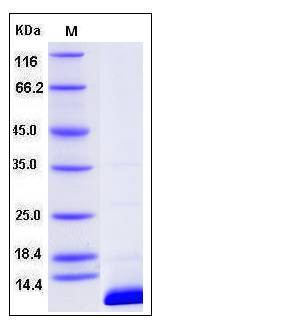Human S100B Protein (His Tag)
NEF,S100,S100-B,S100beta
- 100ug (NPP4240) Please inquiry
| Catalog Number | P10181-H07E |
|---|---|
| Organism Species | Human |
| Host | E. coli |
| Synonyms | NEF,S100,S100-B,S100beta |
| Molecular Weight | The recombinant human S100B consisting of 102 amino acids and migrates as an approximately 12 kDa band in SDS-PAGE under reducing conditions as predicted. |
| predicted N | Met |
| SDS-PAGE |  |
| Purity | > 90 % as determined by SDS-PAGE |
| Protein Construction | A DNA sequence encoding the human S100B (NP_006263.1) (Ser 2-Glu 92) was fused with a polyhistidine tag at the N-terminus. |
| Bio-activity | 1. Measured by its ability to bind human AGER in a functional ELISA. 2. Measured by its ability to bind TP53 in a functional ELISA. |
| Research Area | Epigenetics |Cell cycle |Cell Differentiation |
| Formulation | Lyophilized from sterile PBS, 10% glycerol, pH 7.5 1. Normally 5 % - 8 % trehalose and mannitol are added as protectants before lyophilization. Specific concentrations are included in the hardcopy of COA. |
| Background | S100B is a member of the S100 family of proteins containing two EF-hand-type calcium-binding motifs. S100B exerts both intracellular and extracellular functions. Intracellular S100B acts as a stimulator of cell proliferation and migration and an inhibitor of apoptosis and differentiation, which might have important implications during brain, cartilage and skeletal muscle development and repair, activation of astrocytes in the course of brain damage and neurodegenerative processes, and of cardiomyocyte remodeling after infarction, as well as in melanomagenesis and gliomagenesis. As an extracellular factor, S100B engages RAGE (receptor for advanced glycation end products) in a variety of cell types with different outcomes (i.e. beneficial or detrimental, pro-proliferative or pro-differentiative) depending on the concentration attained by the protein, the cell type and the microenvironment. This calcium binding astrocyte-specific cytokine, presents a marker of astrocytic activation and reflects CNS injury. The excellent sensitivity of S100B has enabled it to confirm the existence of subtle brain injury in patients with mild head trauma, strokes, and after successful resuscitation from cardiopulmonary arrest. Recent findings provide evidence, that S100B may decrease neuronal injury and/or contribute to repair following traumatic brain injury (TBI). Hence, S100B, far from being a negative determinant of outcome, as suggested previously in the human TBI and ischemia literature, is of potential therapeutic value that could improve outcome in patients who sustain various forms of acute brain damage. |
| Reference |
